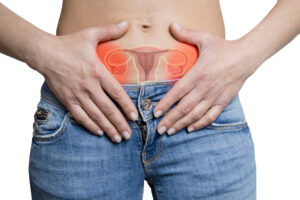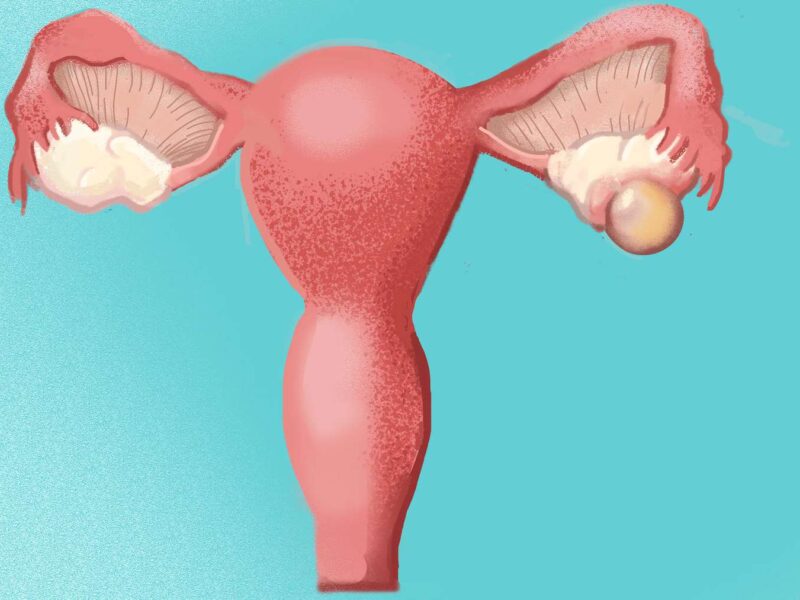Ovarian cysts are fluid-filled sacs that develop on the ovaries and are a common gynaecological concern among women of reproductive age. While many ovarian cysts are asymptomatic and resolve spontaneously, others can cause a range of symptoms and complications that impact a woman’s quality of life.
This essay delves into the diverse symptoms and signs associated with ovarian cysts, including pelvic pain, bloating, irregular menstrual cycles, pain during intercourse, and potential complications such as ovarian torsion or rupture.
Symptoms and Signs Associated with Ovarian Cysts

- Pelvic Pain: Pelvic pain is one of the most common symptoms associated with ovarian cysts. It may manifest as dull, aching discomfort or sharp, stabbing pain in the lower abdomen or pelvic region. The intensity of pain can vary and may be constant or intermittent, depending on the size and location of the cyst. Pain may worsen during menstruation, ovulation, or sexual activity.
- Bloating: Bloating is a sensation of abdominal fullness or swelling that may accompany ovarian cysts. Women with ovarian cysts may experience bloating due to fluid accumulation in the abdominal cavity or compression of nearby organs by the cyst. Bloating may be more pronounced before menstruation or after consuming certain foods, and it may contribute to feelings of discomfort and distension.
- Irregular Menstrual Cycles: Ovarian cysts can disrupt normal menstrual cycles, leading to irregularities in the timing, duration, and flow of menstruation. Women with ovarian cysts may experience changes in their menstrual patterns, including irregular periods, heavy or prolonged bleeding, or spotting between periods. These menstrual irregularities may result from hormonal imbalances caused by the cysts.
- Pain During Intercourse (Dyspareunia): Dyspareunia, or pain during sexual intercourse, is another symptom associated with ovarian cysts. Women with ovarian cysts may experience discomfort or pain during intercourse due to pressure or friction on the ovaries or surrounding tissues caused by the cysts. The pain may be localized to the pelvic area or may radiate to other parts of the abdomen or lower back.
- Urinary Symptoms: Some women with ovarian cysts may experience urinary symptoms such as urinary frequency, urgency, or difficulty emptying the bladder. These symptoms may occur due to compression of the bladder or ureters by large cysts, leading to obstruction or irritation of the urinary tract. In severe cases, urinary retention or urinary tract infections may develop.
- Gastrointestinal Symptoms: Ovarian cysts can cause gastrointestinal symptoms such as nausea, vomiting, constipation, or diarrhoea. These symptoms may arise due to compression of the intestines or disruption of normal bowel function by large cysts. Women with ovarian cysts may also experience changes in appetite or weight loss/gain as a result of gastrointestinal disturbances.
Complications: Ovarian Torsion and Rupture
In addition to the aforementioned symptoms, ovarian cysts can lead to serious complications such as ovarian torsion or rupture. Ovarian torsion occurs when a cyst causes the ovary to twist on its supporting ligaments, resulting in sudden and severe pelvic pain, nausea, vomiting, and possible ovarian ischemia.
Ovarian rupture, on the other hand, occurs when a cyst bursts, releasing its contents into the abdominal cavity and causing intense pain, internal bleeding, and potentially life-threatening complications.
Treatment options for Ovarian cysts
- Watchful Waiting: Watchful waiting, also known as observation or active surveillance, involves monitoring the growth and progression of ovarian cysts over time without immediate intervention. This approach is often recommended for small, asymptomatic cysts that are unlikely to cause complications or resolve spontaneously. Regular follow-up examinations, including pelvic ultrasound, may be performed to assess cyst size and monitor for changes in symptoms.
- Hormonal Therapy: Hormonal therapy, such as oral contraceptives (birth control pills), can help regulate menstrual cycles and prevent the formation of new ovarian cysts. Birth control pills containing estrogen and progestin work by suppressing ovulation and reducing ovarian activity, which can help shrink existing cysts and prevent the development of new ones. Hormonal therapy may be recommended for women with recurrent functional cysts or hormonal imbalances.
- Minimally Invasive Surgery (Laparoscopy): Laparoscopic surgery, also known as minimally invasive surgery, is a common approach for the removal of ovarian cysts that are causing symptoms or complications. During laparoscopy, small incisions are made in the abdomen, and a thin, flexible instrument called a laparoscope is inserted to visualize the ovaries and surrounding structures. The cyst may be drained or excised using specialized surgical instruments, and the incisions are closed with sutures or adhesive strips. Laparoscopic surgery offers several advantages over traditional open surgery, including shorter recovery times, reduced postoperative pain, and lower risk of complications such as infection and adhesions.
- Open Surgery (Laparotomy): In cases where ovarian cysts are large, complex, or suspected to be malignant, open surgery, or laparotomy, may be necessary. Laparotomy involves making a larger incision in the abdomen to access the ovaries and surrounding tissues directly. This approach allows for better visualization and manipulation of the cyst and facilitates the removal of larger or more adherent cysts. Open surgery may be indicated for the treatment of ovarian cysts associated with ovarian torsion, rupture, or suspected malignancy, as well as for women who are not suitable candidates for laparoscopic surgery due to anatomical factors or medical conditions.
- Adjuvant Therapies: In addition to surgical and medical interventions, adjuvant therapies such as pain management, supportive care, and lifestyle modifications may be recommended to alleviate symptoms and improve quality of life for women with ovarian cysts. Nonsteroidal anti-inflammatory drugs (NSAIDs) may be prescribed to relieve pelvic pain and discomfort, while heat therapy, relaxation techniques, and physical activity may help manage stress and promote overall well-being.
Psychological Impact
Beyond the physical symptoms, ovarian cysts can also have a significant psychological impact on affected individuals. Women with ovarian cysts may experience anxiety, fear, or emotional distress related to uncertainty about their condition, concerns about fertility or cancer, and the impact of symptoms on daily activities and relationships.
Conclusion
Ovarian cysts can manifest with a wide range of symptoms and signs, including pelvic pain, bloating, irregular menstrual cycles, pain during intercourse, and potential complications such as ovarian torsion or rupture.
Recognizing and understanding these symptoms is essential for timely diagnosis and appropriate management of ovarian cysts, ensuring optimal outcomes and quality of life for affected individuals. Early detection and intervention can help alleviate symptoms, prevent complications, and address any underlying concerns related to ovarian cysts.
Related Tags
Taiwo Olawuyi
Taiwo Olawuyi is a highly dedicated and passionate professional blogger, renowned for her ability to create captivating, informative, and engaging content in the realm of health and wellness. She holds a Bachelor's degree in Political Science from Olabisi Onabanjo University and a Master's degree in Adult Education from the prestigious University of Ibadan. Her profound passion for health and wellness, coupled with her unwavering dedication to her audience, serves as a constant source of inspiration and enlightenment for readers worldwide.










